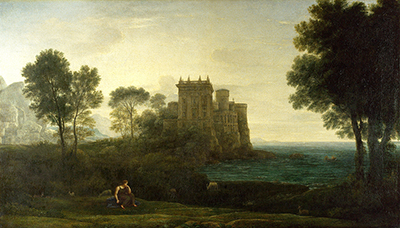Landscape with Psyche Outside the Palace of Cupid is a 1664 oil painting by Claude Lorrain which forms part of the National Gallery collection within the UK. The composition is slightly unusual for this artist for a number of reasons.
Claude places a castle directly in the centre of the painting, giving it the prominence within this work. Normally, the artist placed classical architecture down the two flanks of his paintings, and then allowed other elements to dominate the central section. His is therefore changing the focus for this piece, and allowing architecture to be the main subject, and reflects that in the title. The artwork is also sometimes known instead as The Enchanted Castle and is believed to have been commissioned by Lorenzo Onofrio Colonna, a Roman aristocrat. The artist spent most of his working life living in the city of Rome and it would influence much of his artistic style. Claude was taught by several landscape painters, which explains his concentration on this genre, and other cultural elements of the city's history would also influence different sections of his paintings, including the landcapes as well as the architecture. Castles were a popular choice for artists for many centuries, because of the beauty that many held, but also in the symbolic values that they could deliver to an artwork.
The Golden Ass (IV-VI), by Apuleius would provide the inspiration for this painting. The story tells of Psyche's arrival in Cupid's Kingdom, with the mood of this content being relatively subdued. Psyche is sat outside the castle, either prior to meeting Cupid or after he has rejected her and forced her to leave. Claude regularly featured characters such as this about to leave, where as most other artists who choose different ways to depict a particular story. The Frenchman regularly included embarkations, where his skills with depicting tall ships and harbours could be utilied. Figurative art, by contrast, was not his strength at all, and so figures would always be relatively small, allowing the surrounding landscapes to take most of the attention.
The National Gallery, London typically has this piece out on display alongside a number of other artworks by Claude. They have over a dozen of his artworks within their permanent collection, with other notable entries including the likes of Landscape with David at the Cave of Adullam, Landscape with Cephalus and Procris reunited by Diana, Landscape with a Goatherd and Goats and also Landscape with Hagar and the Angel. British art collectors became enthused for several centuries by this artist and worked hard to acquire as many of his paintings as possible, with most of them eventually falling into the hands of public collections. These would inspire several generations of British artists who made this genre something of a specialty within the UK. Today his career is perhaps regarded as highly within the UK as anywhere else in the world and his reputation continues to draw young people into the world of landscape and seascape art for the first time.




